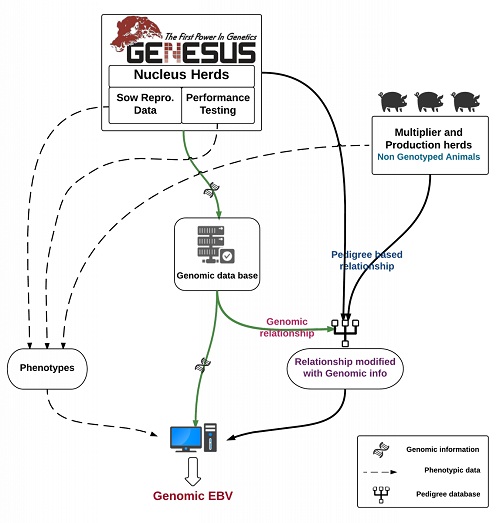



Improving Sow Reproductive Efficiency Using Genomic Selection
GLOBAL - Commercial pig breeding in general follows a crossbreeding program, where the selection decisions are made within a pure breeding nucleus and the final slaughter pigs are produced from crossbreeding in commercial herdsThese kind of mating programs utilize individual and maternal heterosis in both commercial and parental generations, and are widely accepted. (See a detailed discussion about heterosis here: http://www.genesus.com/global-tech-report/heterosis). The male selection candidates at the nucleus are first selected at birth based on parental information, and then the final selections for boars and gilts are done following a post-weaning performance test after collecting information on traits like growth, feed intake and body composition. Significant genetic progress in these traits has been achieved using pedigree and performance based selection methodologies. However, for traits measured only in one sex (like litter size traits) the estimated breeding value (EBV) accuracies are usually low, since records on these traits are not available for selection candidates at the time of selection (completion of the post-weaning performance test). In pig breeding programs, generally maternal breeding goals have more than 50% of the emphasis on maternal traits, and hence it is beneficial to have as accurate an EBV for maternal traits as possible.
For traits that are difficult to improve by pedigree and performance based selection methods (e.g. maternal traits), genomic selection methods are an option ( http://www.genesus.com/genomics ). Genomic selection methods increase the accuracies of EBVs for selection candidates and this property can be utilized for improving the overall rate of genetic improvement. Briefly, genomic selection methodology can be summarized as follows: First marker effects or single nucleotide polymorphism (SNP) effects are estimated from a population of genotyped animals having both phenotype and SNP information. Later these SNP effects are used to predict the breeding values commonly called a genomic breeding value (GEBV) of young animals that do not have phenotypic records. Research conducted by Genesus has shown that the genomic selection methods can improve accuracies of EBVs significantly. (Details can be found here: Sow lactation performance - http://www.genesus.com/global-tech-report/genomic-prediction and feed efficiency - http://www.genesus.com/global-tech-report/genomic-selection ).
GEBV calculation described above does not utilize phenotypic or pedigree information from the relatives of selection candidates that are not genotyped. But studies have shown that accuracies of genomic selection methodologies can further be increased by combining pedigree and performance information from non-genotyped relatives with genotyped animals. This approach to predict EBVs by using information from genotyped animals and non-genotyped relatives simultaneously was discussed by Legarra et al., (2009), Aguilar et al., (2010) and Christensen and Lund (2010). This method is commonly referred as the single step method of genomic selection. The conventional selection methodologies utilize pedigree based relationships and phenotypes for estimating EBVs. In the single step genomic selection method, the pedigree-based relationship information is modified with relationship information from genotyped animals. These modified pedigree relationships provide a better estimation of relationship between animals and combined with the SNP information provide more accurate EBVs.
- The figure shows a schematic representation of single step method of estimating genomic EBVs, that is being implemented at Genesus.
- The dashed and solid back lines indicate the flow of phenotypic and pedigree based information in the Genesus breeding program.
- The solid green line indicates the flow of new genomic information collected as a part of implementation of genomic selection.
- In the nucleus herds, all selection candidates along with their sires and dams are genotyped
Schematic representation of estimating Genomic EBV

Studies conducted at Genesus have shown that the EBVs estimated for sow efficiency traits by the single step methods are 30 - 50% more accurate than the EBVs derived using pedigree and performance based selection methods. At Genesus we are in the final phase of testing single step genomic selection procedures that will be incorporated into our routine evaluation process in the coming months. This will result in an increased rate of genetic improvement focused on customer profitability.
Dinesh M. Thekkoot, PhD
_______________________
References:
Aguilar I, I. Misztal, D.L. Johnson, A. Legarra, S. Tsuruta, and T.J. Lawlor. 2010. Hot topic: A unified approach to utilize phenotypic, full pedigree, and genomic information for genetic evaluation of Holstein final score. Journal of Dairy Science. 93: 743 – 752
Christensen O. F., and Lund, M. S. 2010. Genomic prediction when some animals are not genotyped. Genetics Selection Evolution. 42, 2
Legarra A, I. Aguilar, and I. Misztal. 2009. A relationship matrix including full pedigree and genomic information. Journal of Dairy Science 92: 4656 – 4663









